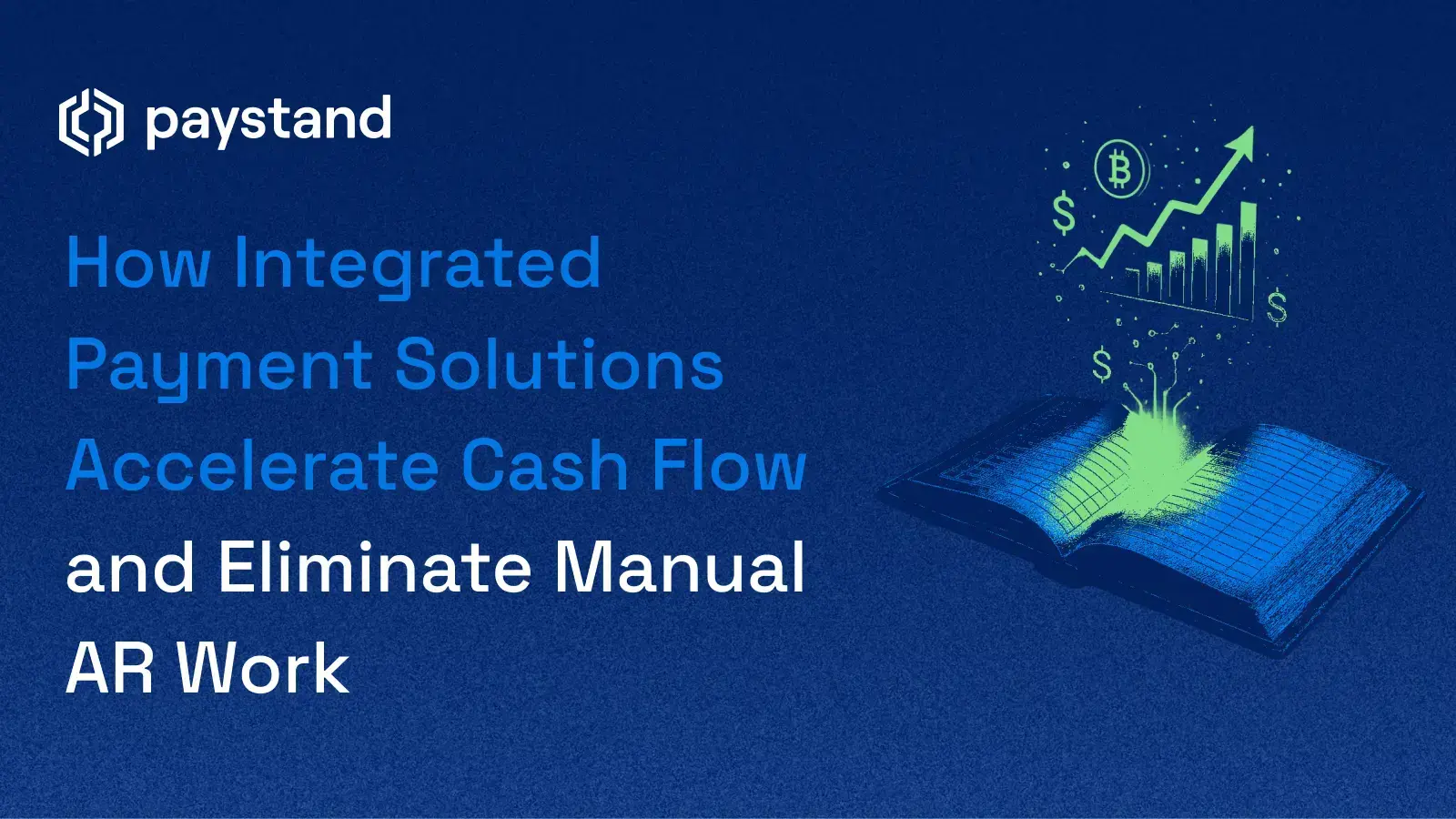How Integrated Payment Solutions Accelerate Cash Flow and Eliminate Manual AR Work

Table of Contents
- What Are Integrated Payments?
- The Benefits of Integrated Payments for Financial Leaders?
- How do Integrated Payments Transform Accounts Receivable Operations?
- How to Choose Integrated Payment Vendors?
- Accelerate Payments Integration with the Right Solution?
Key takeaways
- Integrated payments eliminate manual data entry between payment systems and accounting software, reducing errors and freeing finance teams for strategic work.
- Real-time payment processing and automated reconciliation accelerate cash flow and improve working capital management for Controllers and CFOs.
- Accounts Receivable teams can shift from administrative tasks to predictive collection management through automated payment matching and customer self-service portals.
- Modern integrated payment platforms offer rapid implementation timelines that deliver measurable ROI within weeks rather than months.
Most finance teams today operate with payment systems that create more work than they eliminate. Controllers spend excessive time on month-end reconciliation processes. AR teams manually match payments to invoices. CFOs lack real-time visibility into cash position for strategic planning.
These operational inefficiencies stem from a lack of an integrated payment infrastructure that needs manual intervention at multiple touchpoints. The result is extended DSO, delayed cash conversion, and finance resources allocated to administrative tasks rather than analysis.
Integrated payment solutions address these challenges by connecting payment processing directly with existing ERP and accounting systems. Organizations implementing such solutions report improved payment experiences, which boost conversion rates by 10-15%.
This guide examines how integrated payments transform finance operations and deliver quantifiable ROI.
What Are Integrated Payments?
Integrated payments are automated payment processing infrastructure that connects directly with ERP, accounting, and POS systems to eliminate manual data entry and synchronize financial information in real-time.
For finance leaders, this means payment data flows automatically from transaction to GL entry without human intervention.
This matters because traditional payment processing creates data silos that force finance teams into repetitive reconciliation work. Integrated systems eliminate these friction points, allowing
Controllers to focus on financial analysis rather than data management while providing CFOs with real-time cash visibility for strategic decision-making.
The core value lies in operational transformation. Instead of managing payment data, your team manages payment strategy.
How do Integrated Payments Differ from Traditional Payment Processing?
Traditional payment systems operate in isolation, forcing finance teams to manually extract transaction data from payment processors and enter it into accounting systems. This creates reconciliation bottlenecks where accounts receivable staff spend hours matching payments to invoices, often discovering discrepancies days after transactions occur.
Integrated systems automatically sync payment data with accounting records the moment transactions process. When a customer pays an invoice, the system immediately updates your ERP, adjusts account balances, and creates audit trails, eliminating the manual data transfer that consumes finance resources.
The operational difference is measurable: traditional systems create batch processing delays that extend reconciliation cycles, while integrated systems provide real-time visibility that enables same-day cash application and month-end close acceleration.
What are the Core Payment Integration Points for Finance Teams?
ERP system synchronization is the foundation, automatically generating journal entries when payments are processed and updating balances in real-time. This eliminates the manual posting that typically delays month-end close procedures.
Accounts receivable automation connects payment processing directly with invoice management, automatically matching payments to outstanding invoices and flagging exceptions for review. This streamlines operations by reducing manual matching work that traditionally consumes AR team resources.
Cash management and bank reconciliation integration offer Controllers real-time cash position visibility while automating the reconciliation processes that typically require manual intervention.
The result is that finance teams can focus on cash flow analysis rather than cash flow administration.
The Benefits of Integrated Payments for Financial Leaders
Finance leaders evaluating integrated payments need to understand the specific operational and strategic advantages these systems deliver. The improvements integrated payment solutions offer directly impact the key performance indicators like DSO, cash conversion cycles, month-end close timelines, and forecast accuracy.
Operational Efficiency Gains
Integrated payments eliminate the manual data entry steps that consume significant AR team resources daily. By automating payment posting and reconciliation processes, finance teams can reallocate staff from administrative tasks to strategic collection activities that directly impact customer relationships and payment timing.
The efficiency improvements extend beyond time savings to error reduction. Manual data entry introduces reconciliation discrepancies that require investigation and correction, while automated systems maintain data consistency between payment processing and accounting records.
These operational improvements enable AR teams to shift focus from transaction processing to collection strategy and customer communication, activities that deliver measurable impact on DSO performance and customer satisfaction metrics.
Cash Flow and Working Capital Improvements
Integrated payment systems accelerate payment collection by offering customers convenient digital payment options that reduce friction in the payment process. Companies typically experience faster payment cycles when customers can pay through multiple channels without leaving their existing workflows.
Real-time payment processing and automated settlement eliminate the delays inherent in manual processing workflows. This acceleration improves cash conversion cycles by reducing the time between payment initiation and cash availability for business operations.
Real-time payment visibility ensures better cash forecasts and informed working capital management decisions. When payment data flows immediately into financial systems, cash flow predictions become more reliable, and strategic resource deployment becomes more effective.
Cost Reduction and Risk Mitigation
Streamlined workflows reduce overall payment processing costs by eliminating the labor expenses associated with manual data entry and reconciliation processes. Automated audit trails enhance compliance capabilities while reducing the manual effort required during audit periods.
Comprehensive transaction documentation and automated compliance reporting also reduce audit preparation time for Controllers and their teams. Security also increases, thanks to integrated security protocols that minimize fraud through real-time transaction monitoring and automated exception handling.
These systems provide enhanced payment security oversight while reducing the manual monitoring previously required for fraud prevention activities.
How do Integrated Payments Transform Accounts Receivable Operations?
Integrated payments take AR operations from reactive transaction processing to proactive cash flow management. This transformation directly impacts department efficiency metrics and positions AR teams as revenue enablers rather than back-office administrators. Also helping CFOs become strategic partners in the business, instead of financial statement reviewers.
This shift fundamentally changes how AR contributes to organizational cash flow objectives.
Automated Payment Matching and Exception Handling
Gone are the days of AR staff manually matching payments to invoices. Integrated systems handle this automatically, cross-referencing payment amounts with outstanding invoices and updating balances instantly. No more spreadsheet gymnastics or detective work to figure out which payment belongs where.
The system handles complex scenarios, too. Partial payments get allocated correctly, payment plans update automatically, and customer account histories stay accurate without manual intervention.
Your AR team stops playing payment puzzles and starts managing relationships.
When exceptions do occur, you get targeted alerts instead of having to investigate every transaction. The system does the heavy lifting of detection, and your team focuses on resolution.
Customer Self-Service and Payment Flexibility
Customer portals reduce AR workload, empowering customers to handle common inquiries themselves. They view invoices, download statements, and process payments on their schedule, freeing up your AR team in the process.
Payment flexibility becomes seamless when customers can choose their preferred method without calling your team. Whether they want ACH, credit card, or wire transfer, the system accommodates without creating extra work for AR staff.
Automated reminders handle routine follow-ups, freeing your team up for the conversations that matter. Instead of sending repeated, robotic payment follow-ups, your team can focus on building relationships and nurturing customers through situations that need a special touch.
Advanced AR Analytics and Reporting
Real-time payment patterns reveal which customers consistently pay early, which ones need gentle nudging, and which ones require serious attention. This is where AR teams become strategic players instead of data processors.
You're making decisions based on behavior, not guesswork.
Customer payment tracking informs smarter credit decisions and payment terms. Why offer the same terms to a customer who always pays in 45 days versus one who pays in 15? The data tells the story and prevents you from applying blanket rules that decrease efficiency.
DSO reports generate instantly instead of consuming hours of manual calculation. You get current performance data when you need it, not after the moment has passed.
How to Choose Integrated Payment Vendors
Smart finance leaders approach integrated payment vendor selection systematically, focusing on measurable criteria that directly impact their operational objectives. The goal is to find the vendor that solves your specific pain points while integrating seamlessly with your existing infrastructure.
Here are some guidelines:
- Assess API documentation quality and developer support responsiveness - poor APIs create implementation headaches that delay ROI
- Verify native integration capabilities with your specific ERP system version, not just general compatibility claims
- Request transaction volume scalability metrics and stress testing results from vendors
- Test sandbox environments to validate integration complexity before committing to implementation timelines
- Evaluate real-time data synchronization capabilities and latency performance under typical transaction loads
- Verify compliance certifications relevant to your industry (PCI DSS, SOC 2, GDPR) with recent audit reports
- Audit data encryption standards for both transmission and storage, with particular attention to key management protocols
- Review audit trail capabilities and automated compliance reporting features that reduce manual oversight requirements
- Assess regulatory requirement management across multiple jurisdictions if your business operates internationally
- Compare security enhancement benefits versus current manual process vulnerabilities and exposure risks
- Evaluate implementation support quality through reference calls with similar-sized organizations in your industry
- Assess ongoing technical support availability and response time commitments for critical issues
- Review vendor financial stability and product roadmap alignment with your long-term business objectives
- Analyze the total cost of ownership, including hidden fees, upgrade costs, and transaction volume pricing tiers
Accelerate Payments Integration with the Right Solution
Integrated payments are the foundation for transforming finance teams from cost centers into strategic revenue drivers. The companies gaining a competitive advantage are reimagining how finance and traditional back-office functions like accounts receivable contribute to business growth and scalability.
Paystand delivers this transformation by addressing the core challenges that limit the finance team's strategic impact:
- Zero-fee payment processing improves bottom-line performance while reducing the cost burden that accompanies payment volume growth
- Lightning-fast next-day settlements accelerate cash conversion cycles and improve working capital management, giving you cash flow predictability for strategic investment decisions
- Automated AR processes free Controllers and AR Managers from manual reconciliation work, enabling them to focus on financial analysis and strategic planning that drives business value
- Native ERP integration provides real-time financial visibility, positioning finance as a strategic business partner rather than a reporting function
- Rapid implementation timelines deliver measurable ROI as quickly as 90 days, minimizing operational disruption while accelerating the path to strategic transformation
Integrated payments future-proof your organization and enable you to do more with less. This results in a strategic repositioning of the finance function.
Learn more about how Paystand can transform your AR and company through the power of integrated payments.






